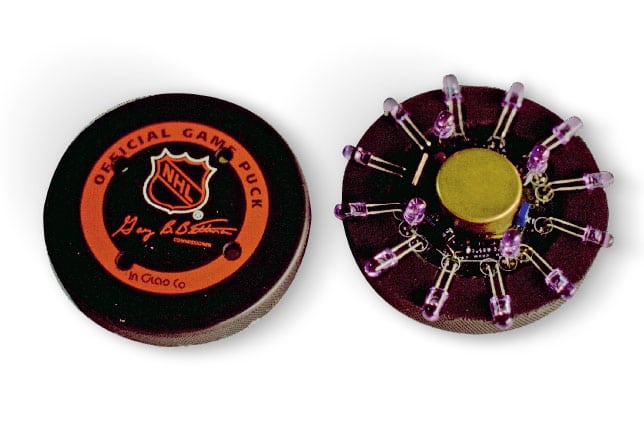
It was loved by some, hated by others. But one thing is certain: the “glow puck” left an indelible mark on TV.
It was loved by some, hated by others. But one thing is certain: the “glow puck” left an indelible mark on TV.

A humble little puck changed television sports forever during the 46th NHL All-Star Game, 20 years ago, in 1996, when the Fox Network debuted its FoxTrax System. It was a special effect that tracked every movement of the puck, then superimposed a bluish glow around it for television viewers – all in real-time. It was the first augmented reality system used in sports, merging computer graphics with live sports. The breakthrough, however, was met with mixed response. “The more casual fans, or even those who were just learning about hockey, tended to love it,” said Rick Cavallaro, the chief engineer and project manager of FoxTrax. “A lot of hardcore fans did not. But even among hardcore fans, a lot of them seemed to like one aspect or another of it.”
The idea for FoxTrax came out of a conversation between David Hill, president of Fox Sports from 1993 to 1997, and Stan Honey, the VP of Technology at News Corp., Fox’s parent company. Fox Sports had acquired the national broadcast rights for NHL games from 1994-95 to 1998-99, and Honey approached Hill with the idea of inserting virtual billboards into live sporting events. But Hill suggested something that would make a bigger splash. “When Fox got the rights to hockey, it was an incredibly low-rated sport in the U.S.,” Hill said. “If you can’t see what the key implement of a sport is doing all the time, you’ll have difficulty following it. So I said, let’s try and make the puck glow.”

A lot was necessary to make the effect work. Infrared emitters and a battery were inserted into a puck, and to pick up the transmitted signal, infrared cameras were situated in the rafters and near the TV cameras. The TV cameras themselves were outfitted with special tripod heads that would detect the pan, tilt and zoom, ensuring that the tracking system and game footage would properly line up. “Our group that developed it did not know the first thing about broadcast sports,” Cavallaro said. “We were a bunch of Silicon Valley geeks. There was a steep learning curve for us.”
All this data was fed into a trailer outside the arena, affectionately dubbed the “Puck Truck.” Computers would read the data and render the bluish glow that was superimposed over the puck. When the puck was obscured by a player or by the near boards, the blue glow would highlight where it was. When the puck was passed, a blue comet tail followed it. Most noticeably, when the puck was shot hard, it was followed by a bright red streak, and viewers could easily see the path of the puck if it was deflected or redirected. A speed readout would also display on-screen if the puck was shot over 70 mph. All of this was accomplished live, needing only a 10-frame delay (about one-third of a second) for the effects to be inserted. “I think what the fans liked the least were the bright graphics,” Honey said. “I don’t know how they would have reacted if we just put a simple mark on the ice under the puck instead.” Many of today’s on-screen graphics seen during televised sports can trace its roots back to the FoxTrax. Honey left News Corp. in 1998 and co-founded Sportsvision, a company that develops enhancement for sports broadcasts. Cavallaro and others from the FoxTrax team joined him. Since then, Sportsvision has developed numerous innovations: the virtual first-down line in football, NASCAR’s racecar tracking system, baseball’s strike zone graphics and the virtual ads on the glass in hockey are all descendants of the glow puck. “Broadcasters have developed a sensitivity about how you use the technology to tell a story, how to do that in a way that adds to the sport instead of getting in the way,” Cavallaro said. “I hope that if (the glow puck) were reintroduced that even hockey fans, the purists, would say that we’re bringing something to the broadcast. I would love a second crack.”
This is an edited version of a feature that appeared in the February 15 edition of The Hockey News magazine. Get in-depth features like this one, and much more, by subscribing now.
